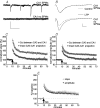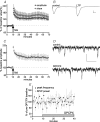Long-term potentiation is impaired in rat hippocampal slices that produce spontaneous sharp waves
- PMID: 15194734
- PMCID: PMC1665012
- DOI: 10.1113/jphysiol.2004.068080
Long-term potentiation is impaired in rat hippocampal slices that produce spontaneous sharp waves
Abstract
Sharp waves (SPWs) occur in the hippocampal EEG during behaviours such as alert immobility and slow-wave sleep. Despite their widespread occurrence across brain regions and mammalian species, the functional importance of SPWs remains unknown. Experiments in the present study indicate that long-term potentiation (LTP) is significantly impaired in slices, prepared from the temporal aspect of rat hippocampus, that spontaneously generate SPW activity. This was probably not due to anatomical and/or biochemical abnormalities in temporal slices because stable LTP was uncovered in field CA1 when SPWs were eliminated by severing the projection from CA3. The same procedure did not alter LTP in slices lacking SPWs. Robust and stable LTP was obtained in the presence of SPWs in slices treated with an adenosine A1 receptor antagonist, a finding that links the present results to mechanisms related to the LTP reversal effect. In accord with this, single stimulation pulses delivered intermittently in a manner similar to the SPW pattern interfered with LTP to a similar degree as spontaneous SPWs. Taken together, these results suggest the possibility that SPWs in the hippocampus constitute a neural mechanism for forgetting.
Figures





Similar articles
-
Adenosine as an endogenous regulating factor of hippocampal sharp waves.Hippocampus. 2009 Feb;19(2):205-20. doi: 10.1002/hipo.20497. Hippocampus. 2009. PMID: 18785213
-
Induction of sharp wave-ripple complexes in vitro and reorganization of hippocampal networks.Nat Neurosci. 2005 Nov;8(11):1560-7. doi: 10.1038/nn1571. Epub 2005 Oct 16. Nat Neurosci. 2005. PMID: 16222227
-
Long-term potentiation is impaired in middle-aged rats: regional specificity and reversal by adenosine receptor antagonists.J Neurosci. 2005 Jun 22;25(25):5956-66. doi: 10.1523/JNEUROSCI.0880-05.2005. J Neurosci. 2005. PMID: 15976084 Free PMC article.
-
Adenosine acting on A1 receptors protects NO-triggered rebound potentiation and LTP in rat hippocampal slices.J Neurophysiol. 2002 Apr;87(4):1781-9. doi: 10.1152/jn.00630.2001. J Neurophysiol. 2002. PMID: 11929899
-
Adenosine antagonists have differential effects on induction of long-term potentiation in hippocampal slices.Hippocampus. 1995;5(1):71-7. doi: 10.1002/hipo.450050109. Hippocampus. 1995. PMID: 7787948
Cited by
-
Effects of μ-opioid receptor modulation on the hippocampal network activity of sharp wave and ripples.Br J Pharmacol. 2013 Mar;168(5):1146-64. doi: 10.1111/j.1476-5381.2012.02240.x. Br J Pharmacol. 2013. PMID: 23043226 Free PMC article.
-
In Vivo Multi-Day Calcium Imaging of CA1 Hippocampus in Freely Moving Rats Reveals a High Preponderance of Place Cells with Consistent Place Fields.J Neurosci. 2022 Jun 1;42(22):4538-4554. doi: 10.1523/JNEUROSCI.1750-21.2022. J Neurosci. 2022. PMID: 35501152 Free PMC article.
-
Induced sharp wave-ripple complexes in the absence of synaptic inhibition in mouse hippocampal slices.J Physiol. 2005 Mar 15;563(Pt 3):663-70. doi: 10.1113/jphysiol.2004.079558. Epub 2005 Jan 20. J Physiol. 2005. PMID: 15661820 Free PMC article.
-
Measuring Sharp Waves and Oscillatory Population Activity With the Genetically Encoded Calcium Indicator GCaMP6f.Front Cell Neurosci. 2019 Jun 19;13:274. doi: 10.3389/fncel.2019.00274. eCollection 2019. Front Cell Neurosci. 2019. PMID: 31275115 Free PMC article.
-
Memory processes during sleep: beyond the standard consolidation theory.Cell Mol Life Sci. 2009 Jul;66(14):2285-97. doi: 10.1007/s00018-009-0019-1. Epub 2009 Mar 26. Cell Mol Life Sci. 2009. PMID: 19322518 Free PMC article. Review.
References
-
- Arai A, Lynch G. Factors regulating the magnitude of long-term potentiation induced by theta pattern stimulation. Brain Res. 1992;598:173–184. - PubMed
-
- Buzsaki G. Hippocampal sharp waves: their origin and significance. Brain Res. 1986;398:242–252. - PubMed
-
- Buzsaki G, Haas HL, Anderson EG. Long-term potentiation induced by physiologically relevant stimulus patterns. Brain Res. 1987;435:331–333. - PubMed
-
- Buzsaki G, Leung LW, Vanderwolf CH. Cellular bases of hippocampal EEG in the behaving rat. Brain Res. 1983;287:139–171. - PubMed
-
- Cohen AS, Abraham WC. Facilitation of long-term potentiation by prior activation of metabotropic glutamate receptors. J Neurophysiol. 1996;76:953–962. - PubMed
Publication types
MeSH terms
Substances
Grants and funding
LinkOut - more resources
Full Text Sources
Miscellaneous

